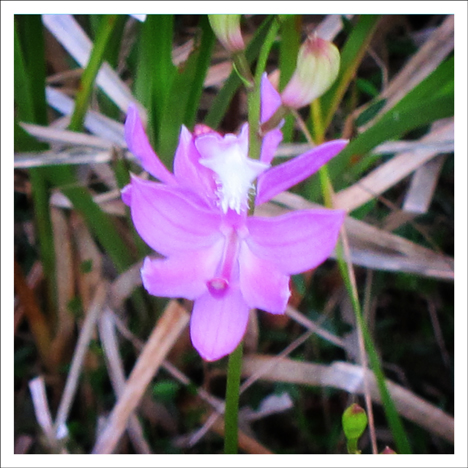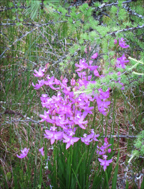Adirondack Wildflowers:
Grass Pink
Orchid (Calopogon tuberosus)
 Adirondack Wildflowers: Grass Pink Orchid blooming on Barnum Bog at the Paul Smiths VIC
Adirondack Wildflowers: Grass Pink Orchid blooming on Barnum Bog at the Paul Smiths VIC
| This page is no longer being updated. For an updated and expanded version of this material, see: Grass Pink (Calopogon tuberosus). |
Calopogon tuberosus, the tuberous grass pink, is native to eastern North America. In the United States, it occurs from as far southwest as Texas and Oklahoma and southeast to the Florida Everglades to as far northeast as Maine and as far northwest as Minnesota. In Canada it is found in the provinces of Nova Scotia, Ontario and Quebec. It also is found in Cuba and the Bahamas. In New York State, it is listed by the USDA as "Exploitably Vulnerable."
 According
to the Wildflower
Center's Native Plan Database, the name "Calopogon"
comes from the Greek words meaning beautiful beard. The prominent
hairs, the beard, on the lip identify it. This species is a plant
of moist areas and is most abundant in pineland bogs. It is known
as grass pink because of the long, narrow, grass-like leaves.
It grows 2 1/2 to 4 feet tall, with 2 or more flowers arranged
along the stem. The blossoms are rose-pink to pale orchid and
are about 2 inches across. This delicate, sweet-smelling orchid
often springs from peat or sphagnum moss and is easily recognized
by the bearded lip petal and solitary, grass-like leaf. Its genus
name is derived from the Greek for beautiful beard, and the species
name is Latin for tuberous.
According
to the Wildflower
Center's Native Plan Database, the name "Calopogon"
comes from the Greek words meaning beautiful beard. The prominent
hairs, the beard, on the lip identify it. This species is a plant
of moist areas and is most abundant in pineland bogs. It is known
as grass pink because of the long, narrow, grass-like leaves.
It grows 2 1/2 to 4 feet tall, with 2 or more flowers arranged
along the stem. The blossoms are rose-pink to pale orchid and
are about 2 inches across. This delicate, sweet-smelling orchid
often springs from peat or sphagnum moss and is easily recognized
by the bearded lip petal and solitary, grass-like leaf. Its genus
name is derived from the Greek for beautiful beard, and the species
name is Latin for tuberous.
 This
lovely orchid is one of many that grow in the Barnum Bog, which
can be accessed via the boardwalk on the Boreal
Life Trail. Grass Pink Orchids usually bloom in late June
and early July.
This
lovely orchid is one of many that grow in the Barnum Bog, which
can be accessed via the boardwalk on the Boreal
Life Trail. Grass Pink Orchids usually bloom in late June
and early July.
